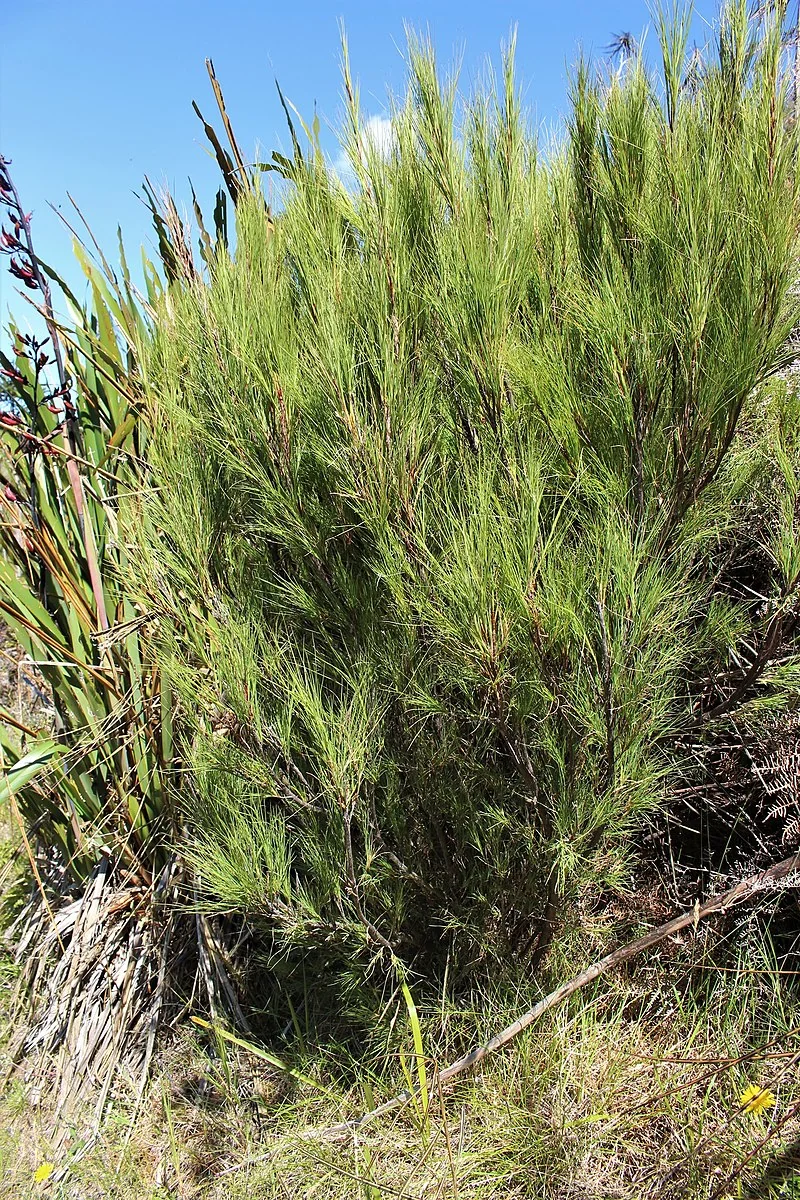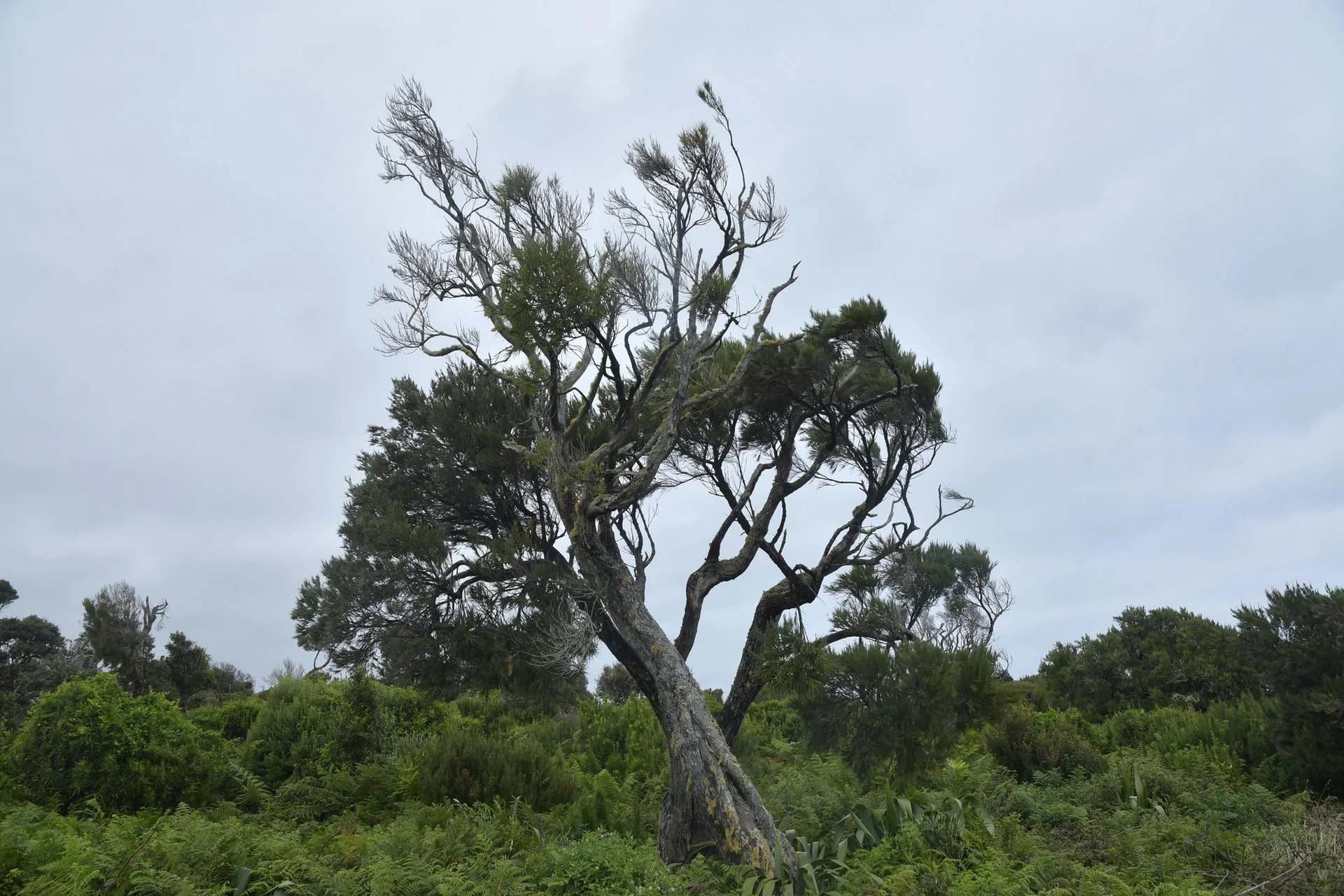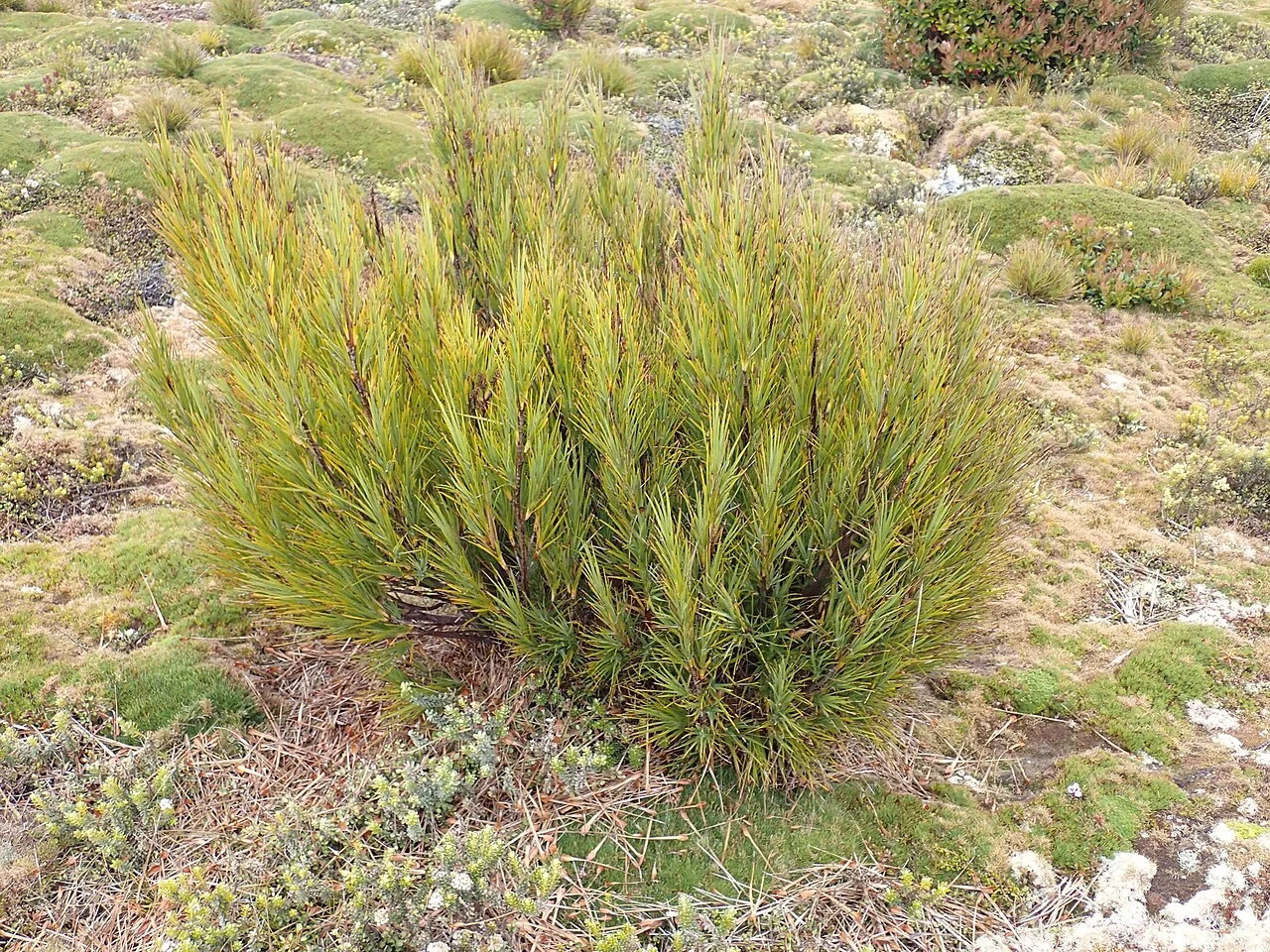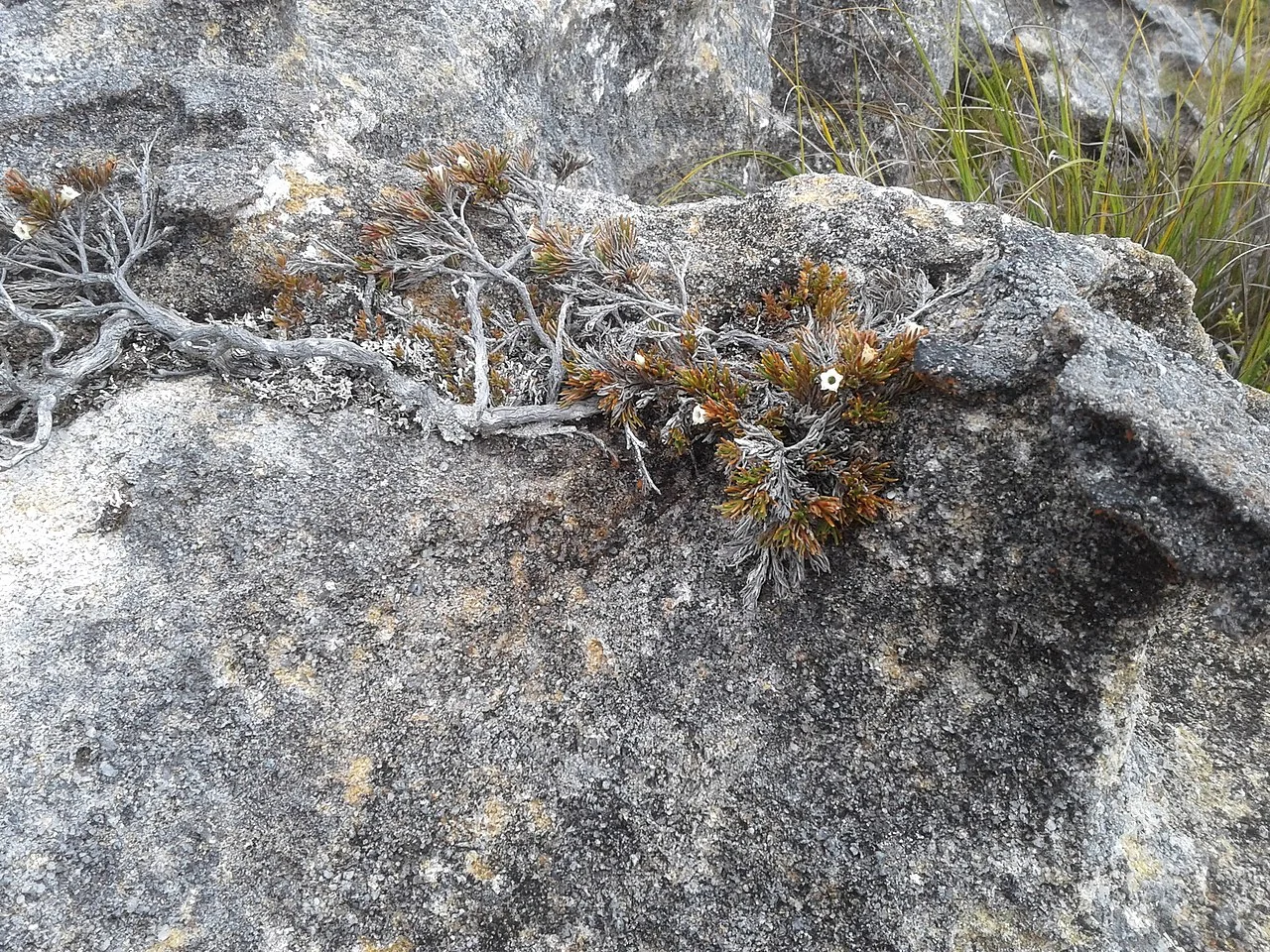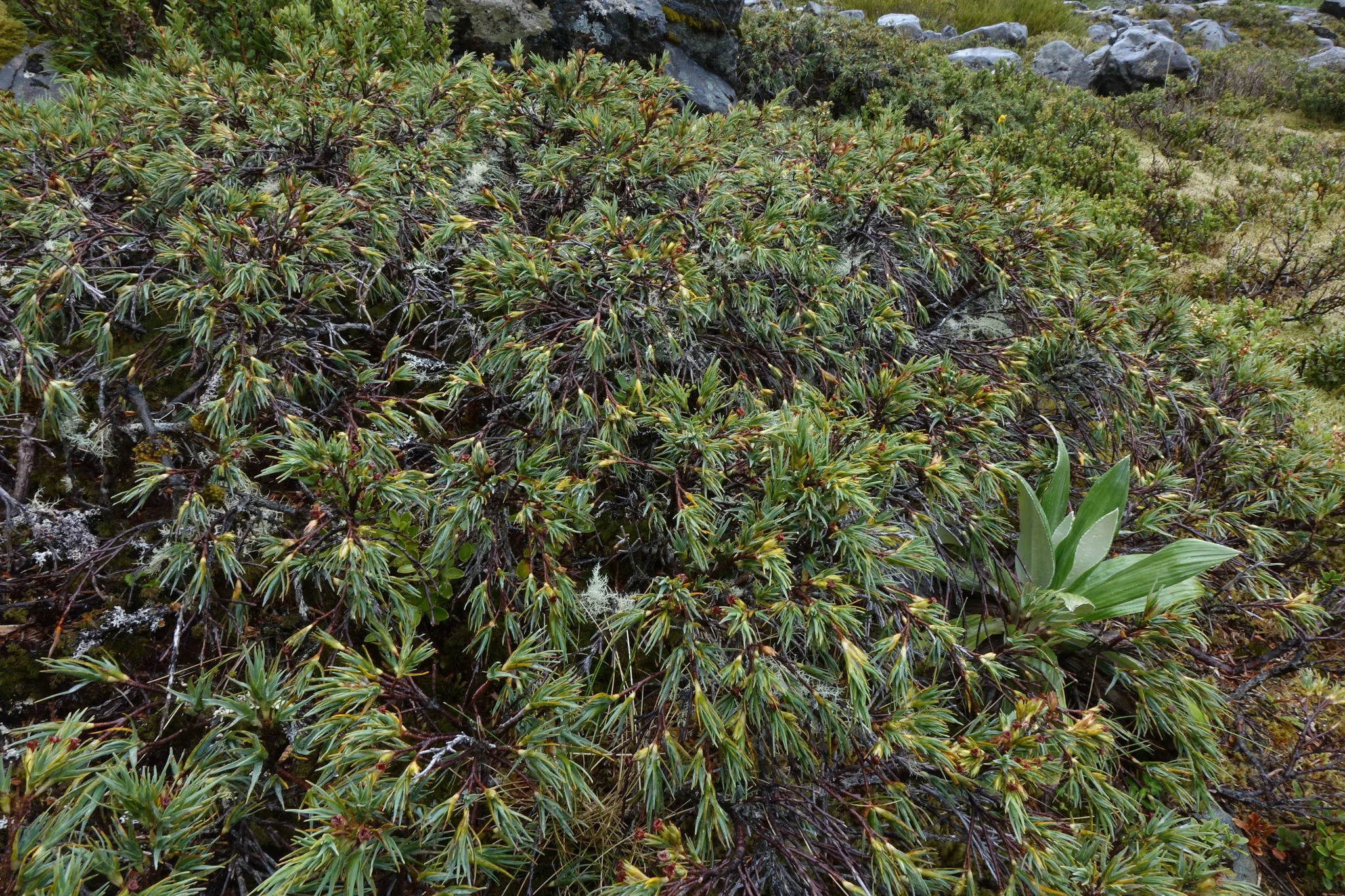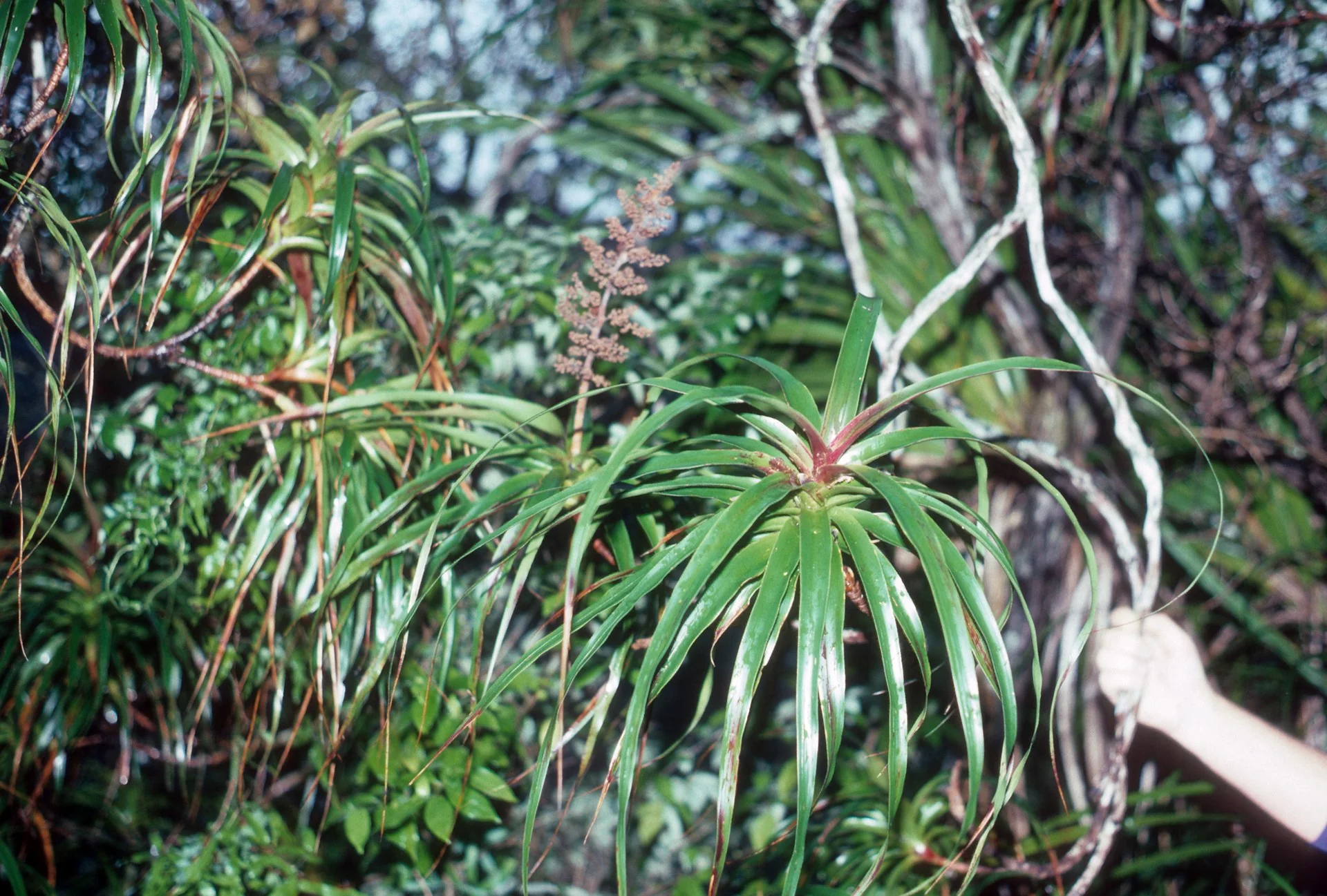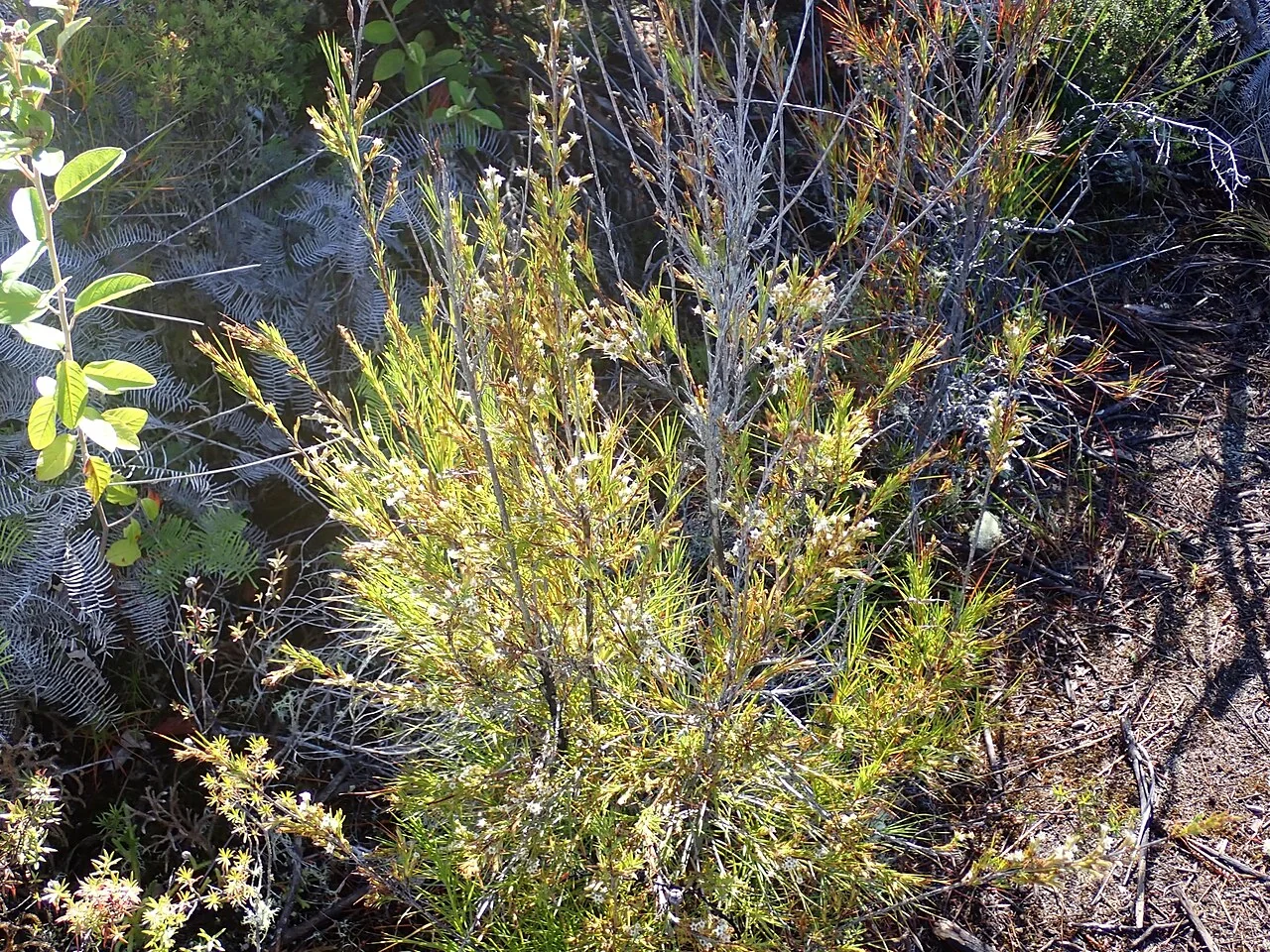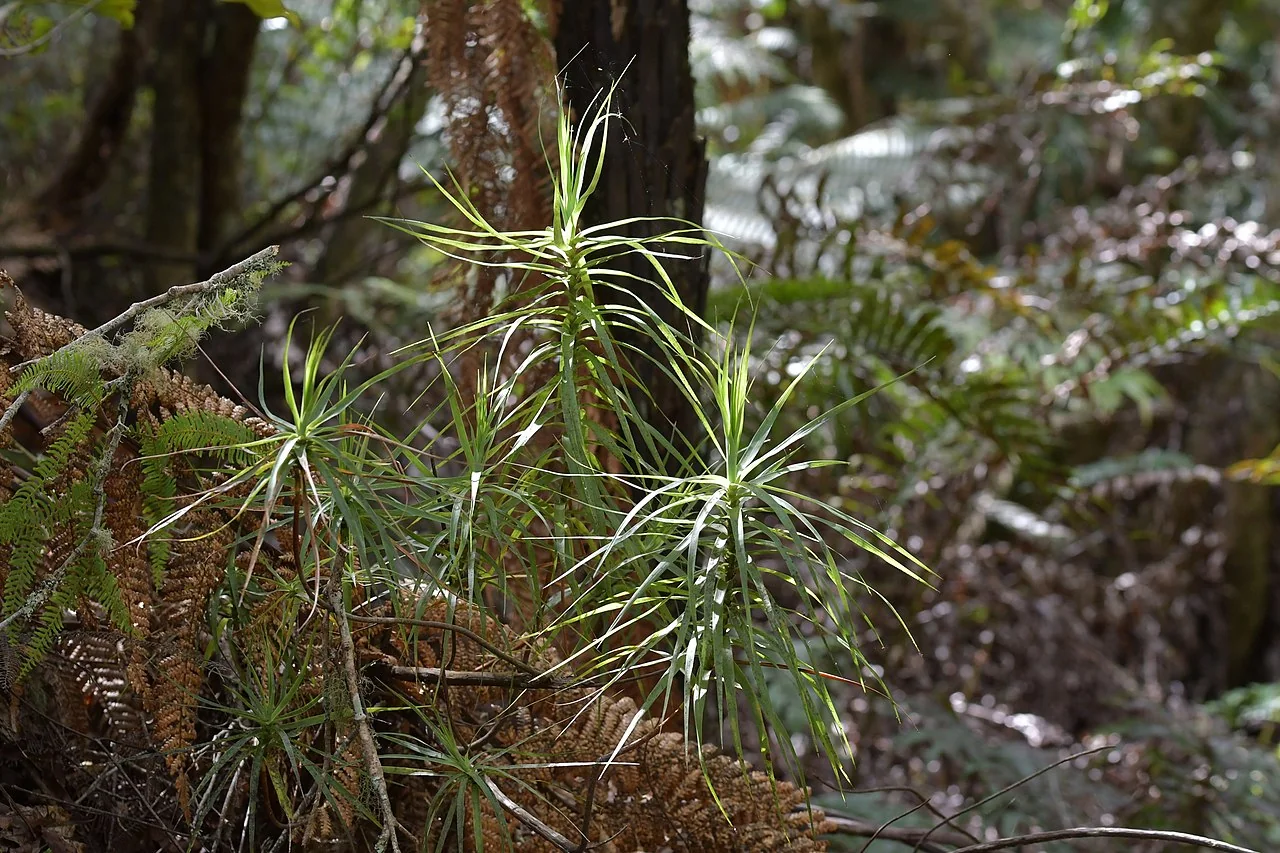
Tī Torowhiti
Dracophyllum strictum
Tī Torowhiti ( Dracophyllum strictum ) represents one of New Zealand's most specialized and regionally restricted native shrubs , creating distinctive spear-like silhouettes against the dramatic landscapes of the northern North Island's volcanic regions and offshore islands. This remarkable endemic species embodies the essence of botanical adaptation to extreme environments, thriving in the harsh, exposed volcanic soils and coastal sites from Thames to East Cape, including the unique ecosystem of Tuhua (Mayor Island). The plant's most striking characteristic lies in its rigid, upright growth form that perfectly matches its scientific name "strictum," with densely packed clusters of glaucous blue-green leaves creating an almost architectural appearance that seems designed to withstand the fierce winds and salt spray of its exposed coastal and volcanic habitats. The distinctive dimorphic foliage demonstrates fascinating developmental adaptations, with juvenile plants producing longer leaves that gradually transform into the characteristic short, rigid adult leaves as the plant matures and adapts to increasingly harsh conditions. During flowering season, Tī Torowhiti produces spectacular displays of dense white to pale pink tubular flowers arranged in conspicuous clusters on bright red stalks, creating a striking colour contrast that makes the plants visible from considerable distances across their sparse volcanic landscapes. The species holds deep cultural significance for local Māori communities, who recognized its exceptional fire-starting properties and gave it the evocative name "turpentine shrub" for its ability to ignite even when wet, making it invaluable for survival in the challenging coastal and island environments where it grows. Found primarily on volcanic substrates and highly exposed sites that few other woody plants can tolerate, Tī Torowhiti serves as both an indicator species for healthy coastal ecosystems and a living symbol of resilience in the face of environmental extremes. The plant's specialized habitat requirements and sensitivity to disturbance make it one of New Zealand's most challenging native species to cultivate, requiring conservation efforts focused on protecting its unique natural environments rather than attempting garden cultivation.

Plant Description
Botanical Features
Dracophyllum strictum , commonly known as Tī Torowhiti, is a shrub or small tree endemic to the northern North Island of New Zealand. It typically grows as an erect, multi-stemmed shrub or tree, reaching heights of 0.5 to 3 meters. It features stiffly branched stems with dark brown, finely fissured bark on older branches and yellowish-brown young stems. Its distinctive appearance includes glaucous blue-green foliage, often forming a spear-like silhouette due to leaves arranged in dense tufts at shoot tips. The leaves are linear-triangular to lanceolate, measuring 47-75 mm long by 5-8 mm wide, with finely serrulate-crenulate margins. It produces dense clusters of white to pale pink tubular flowers, which are typically 4-6 mm long, on short, often pubescent pedicels, followed by small, depressed-globose, light brown to reddish-brown seed capsules. This species is restricted to parts of the northern North Island, thriving in sparsely vegetated volcanic and coastal to subalpine sites with high exposure and excellent drainage.
Quick Facts
| Scientific Name | Dracophyllum Strictum |
|---|---|
| Height | 1-4 m |
| Spread | 1-2 m |
| Water Needs | Low |
| Light | Full sun to part shade |
| Frost Tolerance | Good |
| Salt Tolerance | Good |
| Growth Rate | Slow |
| Lifespan | Long |
Climate Best Suited to
Grass Tree ( Dracophyllum strictum ) prefers well-drained, sunny positions in alpine and subalpine areas. It adapts well to typical New Zealand growing conditions with appropriate care and positioning.
Regional Suitability
| Whangārei | Ideal |
| Auckland | Ideal |
| Hamilton | Suitable |
| Rotorua | Suitable |
| Tauranga | Ideal |
| Gisborne | Ideal |
| New Plymouth | Ideal |
| Whanganui | Ideal |
| Palmerston North | Suitable |
| Napier | Ideal |
| Wellington | Ideal |
| Nelson | Ideal |
| Christchurch | Suitable |
| Dunedin | Suitable |
| Invercargill | Suitable |
| City | Climate Suitability |
|---|
Natural Habitat
Dracophyllum strictum , also known as tōtorowhiti, is a species of shrub endemic to New Zealand. It is primarily found in the North Island, specifically from Thames to East Cape, including Tuhua (Mayor Island). Some sources also indicate its presence extending southward to approximately Westport in the lower North and upper South Islands.
This plant inhabits a range of environments from lowland to montane forest and shrubland. It thrives in coastal to subalpine sites that are sparsely vegetated and exposed to intense sun. Dracophyllum strictum prefers free-draining, mineral soils, often on volcanic substrates such as rhyolite, andesite, and ignimbrite. It can also be found on sandstones and calcareous mudstone. It is commonly found within the ignimbrite country of the Central Volcanic Plateau.
Plant Conservation
Dracophyllum strictum , also known by its Māori name t torowhiti, is a plant species endemic to the North Island of New Zealand. Its conservation status is currently classified as "Not Threatened" as of 2023, a status it has held since at least 2004. This shrub is typically found in coastal to subalpine environments, thriving in well-lit, sparsely vegetated areas. It commonly grows on siliceous rocks such as rhyolite, andesite, and ignimbrite, and occasionally on sandstones and calcareous mudstone. Its distribution spans from Thames and East Cape South, including Tuhua (Mayor Island), with a notable presence in the ignimbrite country of the Central Volcanic Plateau. Conservation efforts for Dracophyllum strictum primarily focus on protecting its natural habitats, as the species is notoriously difficult to propagate. Cultivation attempts have generally proven impractical, with plants being fickle and prone to sudden collapse, even when grown from seed or hardwood cuttings. Therefore, in-situ conservation and habitat preservation are considered the most effective approaches to support this species.
Growing Requirements
Soil Requirements
Grass Tree ( Dracophyllum strictum ) performs best in well-draining soil that retains adequate moisture. Like most New Zealand natives, it prefers soils that don't become waterlogged but maintain consistent moisture levels. Good drainage is essential for healthy root development.
- Well-draining soil essential for healthy growth
- Prefers consistent moisture without waterlogging
- Adapts to various soil types with good drainage
- Benefits from organic matter incorporation
- Mulching helps retain moisture and suppress weeds
Light Requirements
Grass Tree ( Dracophyllum strictum ) performs well in full sun to partial shade conditions. Like many New Zealand natives, it adapts to various light conditions but typically shows best growth and form in positions that receive adequate sunlight throughout the day.
- Full sun to partial shade positions
- At least 4-6 hours of direct sunlight daily
- Tolerates light shade in warmer climates
- Morning sun particularly beneficial
Water Requirements
Grass Tree ( Dracophyllum strictum ) requires regular watering during establishment, typically for the first 1-2 years. Once established, it becomes more drought-tolerant but benefits from consistent moisture during dry periods. Avoid overwatering which can lead to root problems.
- Regular watering during establishment phase
- Moderate drought tolerance once established
- Consistent moisture during dry periods beneficial
- Avoid waterlogged conditions
- Mulching helps conserve soil moisture
Planting Guide
Dracophyllum strictum , also known as Tī Torowhiti, is a distinctive New Zealand native shrub endemic to the North Island, particularly from Thames to East Cape. It is characterized by its glaucous blue-green, grass-like foliage and upright, stiff growth habit, producing white to light pink flowers from October to May.
Important Note on Cultivation:
Dracophyllum strictum is considered very difficult to cultivate and is not commercially available. It should never be removed from its natural habitat. The information below is for theoretical guidance if one were to attempt to grow it from seed or cuttings.
Site Selection:
- Light: Requires full sun and bright, well-lit conditions for optimal growth. It thrives in open, sparsely vegetated sites and struggles in shaded areas.
- Air Circulation: Excellent air circulation is crucial.
- Competition: Prefers low-competition environments.
- Climate: Best suited to temperate coastal to subalpine climates with moderate temperatures. It has good frost tolerance and high salt tolerance, making it suitable for exposed coastal locations.
Soil Requirements:
- Type: Has very specific soil preferences, ideally volcanic substrates such as rhyolite, andesite, or ignimbrite.
- Drainage: Excellent drainage is essential. The plant is highly intolerant of waterlogging. It adapts to poor, rocky, well-draining soils and may benefit from seepage areas with good drainage.
Water Requirements:
- Moisture: Moderate water needs. Consistent moisture is important during the establishment phase.
- Drought Tolerance: Once established, it is drought-tolerant.
- Avoid Waterlogging: Extremely sensitive to waterlogged conditions. Natural rainfall is usually sufficient in suitable sites.
Ecological Role
Environmental Benefits
Dracophyllum strictum , also known as t torowhiti, plays several ecological roles within its native New Zealand habitats. It is an endemic shrub found in specific environments, primarily contributing to rare plant communities.
- Habitat Formation: It is a significant component of sparsely vegetated volcanic and coastal to subalpine sites, exposed ridges, and areas with intense sun and free-draining, mineral soils. It can also colonize open riverbanks or shrubland.
- Structural Support: The plant adds structure to these often harsh and otherwise hostile microsites.
- Resource Provision: Dracophyllum strictum provides nectar resources, supporting local fauna.
- Environmental Stabilization: Its presence aids in the stabilization of the challenging environments where it thrives.
Uses and Significance
Garden Uses
- Excellent for native plant gardens and restoration
- Suitable for naturalistic landscape designs
- Low maintenance once established
- Contributes to local biodiversity
- Attractive to beneficial native wildlife
Cultural Significance
Traditional Uses and Values
Dracophyllum strictum , known by its traditional Māori name t torowhiti, holds cultural significance in Aotearoa (New Zealand). This plant is valued in restoration efforts and gardens for the ecological services it provides. Its distinctive appearance and ecological prominence have made it an important landscape marker and reference point for traditional navigation by Māori.
While Dracophyllum strictum itself has cultural associations, other species within the Dracophyllum genus, such as īnanga (Dracophyllum longifolium), were particularly recognized by Māori for their excellent fire-starting properties. These species were sometimes called "turpentine shrubs" due to their ability to burn well even when wet.
Landscaping Uses
Dracophyllum strictum , also known as t torowhiti, is generally not recommended for typical home landscaping due to its highly specific and challenging cultivation requirements. This New Zealand native shrub thrives in unique volcanic and coastal environments, demanding full sun, excellent drainage, and low-fertility soil, and is intolerant of waterlogging. Its survival is best ensured by preserving its natural ecosystems rather than attempting cultivation in unsuitable conditions.
Specialist Applications:
- Despite these difficulties, Dracophyllum strictum is valued in specialist collections as an educational specimen, showcasing adaptation to harsh, exposed environments.
- While most sources emphasize its difficulty, some suggest it can be a useful, compact species for landscaping in areas south of Auckland, closer to its natural range in the central North Island.
- There are also reports that it can thrive on moist day banks and is considered one of the easier Dracophyllum species to cultivate in northern regions, provided it has rich, moist soil and semi-shade.
However, successful cultivation often requires specialist knowledge and conditions, with efforts generally focused on supporting habitat protection and in-situ conservation.
Seasonal Care Calendar
Spring
Spring is an active growth period for Grass Tree ( Dracophyllum strictum ). New growth emerges and this is an ideal time for planting new specimens. Monitor soil moisture as temperatures warm and growth accelerates.
- Active growth period with new foliage development
- Ideal time for planting new specimens
- Monitor soil moisture as temperatures rise
- Apply organic mulch if needed
Summer
Summer is typically the main growing season for Grass Tree ( Dracophyllum strictum ). Ensure adequate watering during hot, dry periods, especially for young plants. Established plants show good heat tolerance with appropriate care.
- Peak growing season with active development
- Monitor watering needs during hot weather
- Young plants need consistent moisture
- Established plants show good heat tolerance
Autumn
During autumn, Grass Tree ( Dracophyllum strictum ) begins to slow its growth as temperatures cool. This is another good time for planting as conditions become more favorable. Reduce watering frequency but maintain soil moisture.
- Growth slows as temperatures moderate
- Good time for planting new specimens
- Reduce watering frequency gradually
- Maintain soil moisture without overwatering
Winter
Winter is typically a dormant period for Grass Tree ( Dracophyllum strictum ), with minimal growth activity. Reduce watering but ensure plants don't completely dry out. Most New Zealand natives are cold-hardy and require minimal winter protection.
- Dormant period with minimal growth activity
- Reduce watering but avoid complete drying
- Generally cold-hardy in most New Zealand climates
- Minimal winter protection required
When to Prune and How Much
Grass Tree ( Dracophyllum strictum ) generally requires minimal pruning to maintain its natural form and health. Most maintenance involves removing dead or damaged growth and light shaping if needed.
- Remove dead, damaged, or diseased growth as needed
- Light pruning to maintain shape if desired
- Prune after flowering if applicable
- Avoid heavy pruning which can stress the plant
- Use clean, sharp tools to prevent disease
- Most natives maintain good form without regular pruning
Always use clean, sharp tools when pruning to minimize disease risk. Native plants typically maintain their natural form well and often require less intervention than exotic species.
How to Grow Tī Torowhiti
Tī Torowhiti, a distinctive and hardy native shrub, adds a unique architectural element to any garden with its upright growth habit and glaucous blue-green leaves. Perfectly adapted to exposed coastal and volcanic sites, it is a resilient choice for challenging environments where other plants struggle. While it is a slow-growing species, its unique aesthetic and ecological importance make it a rewarding plant to cultivate. Understanding its propagation methods is key to successfully growing this specialized species.
From Seed
Propagating Tī Torowhiti from seed can be a slow process, but it is often the most reliable method for this species. Collect fresh seeds when ripe, typically in late summer or autumn. Sow the seeds onto a well-draining seed-raising mix, lightly covering them with a thin layer of fine grit or sand. The seeds may benefit from a period of cold stratification (placing seeds in a moist medium in the refrigerator for 4-6 weeks) to improve germination rates. Maintain consistent moisture in the seed tray and provide cool, bright conditions. Germination can be erratic and may take several months. Once seedlings have developed a few true leaves, they can be potted into individual containers and grown in a sheltered location before planting out.
From Cuttings
Tī Torowhiti can also be propagated from semi-hardwood cuttings, typically taken in late summer or early autumn from healthy, current season's growth. Cuttings should be about 4-6 inches long. Remove the lower leaves and dip the cut end in a rooting hormone. Plant the cuttings into a well-draining, sterile cutting mix, such as a blend of perlite and sand. Maintain high humidity around the cuttings, perhaps by placing them under a plastic dome or in a propagator, and provide bottom heat to encourage root development. Keep the medium consistently moist but not waterlogged. Rooting can be slow and success rates can vary, making this method more suitable for experienced propagators.
Pests and Diseases
Dracophyllum strictum , also known as t torowhiti, is a New Zealand native plant that is notoriously difficult to cultivate and is more susceptible to "sudden collapse" due to environmental factors than specific pests or diseases.
Primary Challenges in Growing Dracophyllum Strictum :
- Root Sensitivity: The plant is extremely sensitive to any disturbance of its roots.
- Cultural Stress: It is prone to failure if not provided with precise growing conditions.
- Waterlogging: Dracophyllum strictum has a fatal sensitivity to poor drainage.
- Competition: It struggles in areas with high plant competition.
These factors often lead to the sudden, unexplained death of the plant. While general plant diseases can be caused by fungi, bacteria, viruses, and other pathogens, there is no specific mention of common pests or diseases that typically affect Dracophyllum strictum . Its resilience in its natural, challenging open habitats suggests that when grown in suitable conditions, it is less prone to external biological threats.
Bonus Tip
Expert Growing Advice
Dracophyllum strictum , or t torowhiti, is a plant full of fascinating details! Its specific epithet "strictum" comes from the Latin word for "upright, stiff," perfectly describing its rigid growth habit. Even more intriguing are its dimorphic leaves, meaning its juvenile and adult leaf forms change dramatically, creating striking architectural effects. Despite its unique beauty, this plant is notoriously difficult to cultivate, often prone to "sudden collapse" if its precise environmental needs aren't met. It's a true specialist, best admired in its natural, wild habitat where it thrives in challenging volcanic and coastal environments.
